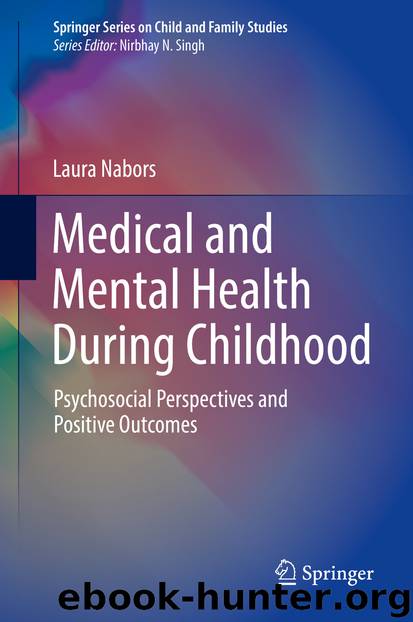Medical and Mental Health During Childhood by Laura Nabors

Author:Laura Nabors
Language: eng
Format: epub
Publisher: Springer International Publishing, Cham
Psychosocial and Emotional Functioning
There is a high degree of parent stress and parents have a significant amount of “burden” or caregiver burden when caring for their child with ASD (Kogan et al., 2009). The burden typically is consistent with the degree of impairment that the child is experiencing. Children with ASD can have different types of emotional and behavioral problems (Maskey, Warnell, Parr, Le Couteur, & McConachie, 2013). Children can display aggression, as well as problems with sleep and eating. In terms of eating behaviors, children can be quite “picky,” liking only certain food textures or eating only certain types of foods (children may eat only a very limited range of foods). Children can be very active or inactive, with differences in activity level that are very different from what might be considered “normal” for children. Children with ASD may be less sensitive to pain, and have difficulty letting adults know what they are experiencing pain. When feeling frustrated, which may be exacerbated by low abilities to communicate using language , children with ASD may be likely to engage in self-injurious behaviors. Two examples of self-injurious behaviors include head-banging and hand-biting. The impact of self-injurious behaviors can be especially concerning if the child has a diminished pain response, because he or she might not feel pain when engaging in self-injurious behavior. Children can also have unique sensory preferences, such as preferences for flashing lights and spinning objects, and they may engage in stereotypies. When these sensory preferences are repeated for self-stimulation, these sensory behaviors are the types of repetitive behaviors (stereotypies) which can be hallmark features when making a diagnosis of ASD. Children with ASD can experience a great deal of anxiety, in social situations and when their routines change.
Children with ASD often experience significant deficits in social skills and have great difficulties in making friends (see Petrina, Carter, & Stephenson, 2014 for a review). They may not make “good eye contact” and have difficulty looking another person “in the eye.” They may have difficulty using the words “you” and “I” in social conversations. If the child is “echoing” parts of what the other children are saying this can be frustrating to the child’s peers. The other children, who are interacting with the child with ASD, may feel that the child is not able to have a conversation with or play with them. Children with ASD may have difficulty taking turns in conversations and talking about others’ interests or taking others’ perspectives, making social interactions between them and their peers very awkward. Children with ASD may have few friends and feel lonely. Many of the children can identify what friendships are and understand that they have difficulty socially and have few friends. Children with ASD may be satisfied with the friends they have, however. Petrina et al. (2014) have called for more research to determine satisfaction with existing friendships for children who have ASD. It is important to note that a lack of social bonds and social development is a
Download
This site does not store any files on its server. We only index and link to content provided by other sites. Please contact the content providers to delete copyright contents if any and email us, we'll remove relevant links or contents immediately.
I Capture the Castle by Dodie Smith(1985)
Aspergirls by Rudy Simone(1655)
Be Different by John Elder Robison(1603)
Autism's False Prophets by Paul A. Offit(1496)
My Child's Different by Elaine Halligan(1462)
Smart but Scattered—and Stalled by Richard Guare(1457)
101 Tips for the Parents of Boys with Autism by Ken Siri(1434)
What's Making Our Children Sick? by Michelle Perro(1384)
Asperger Syndrome (Autism Spectrum Disorder) and Long-Term Relationships by Ashley Stanford(1376)
ADHD by Mark Selikowitz(1353)
On Immunity: An Inoculation by Biss Eula(1338)
Girlish by Lara Lillibridge(1335)
Nerdy, Shy, and Socially Inappropriate by Cynthia Kim(1310)
An Adult with an Autism Diagnosis by Gillan Drew(1306)
Animal-assisted Interventions for Individuals with Autism by Temple Grandin(1283)
Sarah's Child (Hqn Romance) by Linda Howard(1271)
Seeing Ezra by Kerry Cohen(1263)
The Cities by K.A Knight(1238)
Why Gender Matters by Leonard Sax M.D. Ph.D(1220)
